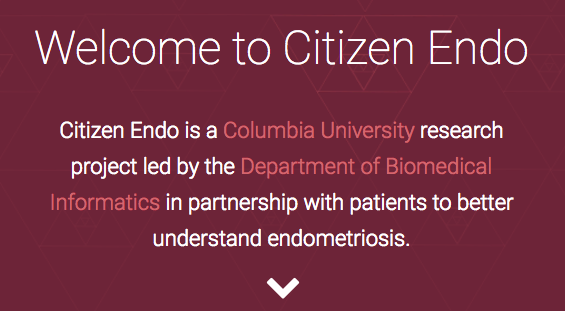 Today, one in ten women are living with endometriosis. You don’t need to look far to find a Tweet, Facebook post or blog entry by someone you know living with the disease. So far in 2017, when it comes to endometriosis, patient advocacy, storytelling and education is on the rise.
Today, one in ten women are living with endometriosis. You don’t need to look far to find a Tweet, Facebook post or blog entry by someone you know living with the disease. So far in 2017, when it comes to endometriosis, patient advocacy, storytelling and education is on the rise.
Researchers, rather than hypothesize about the symptoms and treatment options, are instead including the patient in their research. For example, Citizen Endo is a research project birthed out of Columbia University Medical Center. The project aims to better understand the disease, by first understanding the patient. The website notes:
There is a disconnect between how doctors think about the disease and what patients experience on a daily basis. Bridging this gap is critical to further research on endometriosis.
There’s an app for endo
One way to understand the disease is by giving patients the opportunity to track their symptoms on a customized endometriosis app designed by the team at Columbia called Phendo. Patients simply download the free app, enter symptoms, and the team at Columbia collects the data for analysis.
Further patient engagement is taking place at the Feinstein Institute for Medical Research with their ROSE (Research Outsmarts Endometriosis) Study. The study’s webpage states that ROSE seeks to “investigate the causes of endometriosis and bring improved diagnostics and treatments for women with endometriosis”. Through the collection of a menstrual flow sample (via The DivaCup), researchers are looking for similarities and variance in the stem cell make-up of flow. What is unique about ROSE is that the samples are not only from those living with the disease. Samples are also being collected by family members, both those who have endometriosis and those who do not.
The Smart Tampon
Taking flow sample analysis one step further, a 2016 article on Romper.com featured a story about NextGen Jane and their Smart Tampon. NextGen Jane was started by Ridhi Tariyal and Stephen Gire who met at the infectious disease lab at Harvard University. The two noticed gaps in the health-care system for diagnosing women with diseases such as an STI. While most doctors recommend a well woman visit once a year. Tariyal and Gire wonder what support do women have for the 364 days in between visits?
Still in development, the Smart Tampon will address this gap by empowering women with knowledge about their health. In turn, women can seek support before an infection has spread or before a disease has progressed. The tampon will allow users to collect a sample of flow at home which will then be run through a series of tests for diagnoses. The Smart Tampon will be able to diagnosis endometriosis, STIs, iron deficiency and cervical cancer to name a few.
At what cost? To what benefit?
While knowledge is power, the Smart Tampon has its limits. Unlike Phendo and the ROSE study, the Smart Tampon comes with a cost. Women need to purchase the device, and may also need to pay for the tests. Last May, The Fast Company featured an article that cited the Smart Tampon as the “quantified vagina”, similar to the quantified self movement of lifestyle apps.
NextGen Jane’s website is full of aspiring promises to empower through self-reflection, to educate and provide health insight, but at what cost? At first glance, the idea is brilliant. At second glance, it seems like an attempt to commercialize and capitalize on reproductive infections and disease.
Furthermore, will any diagnosis by the Smart Tampon be considered credible within the medical field? Will an endometriosis diagnosis result in support or treatment from the medical community? If lab tests confirm an STI, will it be enough to get a prescription for antibiotics? Will health benefit plans cover the tests or Smart Tampon device? The Smart Tampon, in theory, has potential, but without collaboration from the medical community, or health plans, most struggling with reproductive ailments will not be able to invest in the technology.
Is cheap, rapid diagnosis on its way?
A new San Francisco-based organization may have found a simple solution to the cost of endometriosis diagnosis. Heather Bowerman from Dot Laboratories has designed a blood test that can identify the disease within one day of analysis. Since the average time for endometriosis diagnosis is ten years, this test could change the future of endometriosis treatment. ABC.net reported on March 2, 2017, that while still in the initial trial phase of the project, the results thus far have been promising. A few pharmaceutical companies are hoping to partner with Bowerman for further development.
Mark Endometriosis Awareness Month by sharing information about these current research initiatives. Whether you live with the disease, or know someone who does, it’s one way we can contribute to better overall understanding of the disease.
When she is not writing and researching about the menstrual cycle and woman’s health for Diva International Inc., or blogging for Menstruation Matters, you will find Sophie Zivku trying out new recipes, reading, attempting to knit and spending time with her ever-growing family in Ontario, Canada.

